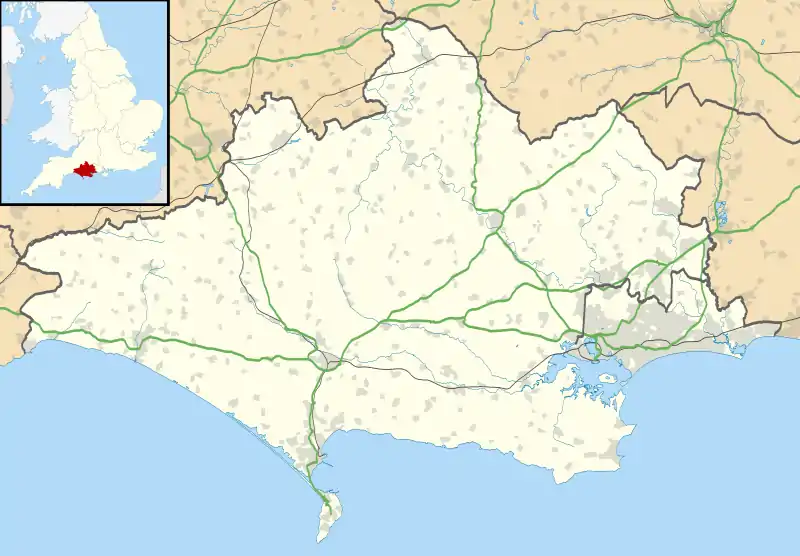Wor Barrow
Wor Barrow is a Neolithic long barrow on Cranborne Chase, about 1 mile (1.6 km) east of Sixpenny Handley in Dorset, England. It is a scheduled monument.[1]
_and_hedgerow_-_geograph.org.uk_-_340611.jpg.webp) Viewed from the north-west | |
 Shown within Dorset | |
| Location | near Sixpenny Handley, Dorset grid reference SU 012 173 |
|---|---|
| Coordinates | 50°57′18.7″N 1°59′1.9″W |
| History | |
| Periods | Neolithic |
| Site notes | |
| Excavation dates | 1893–1894 |
| Archaeologists | Augustus Pitt Rivers |
| Designated | 11 November 1954 |
| Reference no. | 1020066 |
Its excavation by Augustus Pitt Rivers in 1893–1894 has been described as "an important event in the study of British archaeology".[2]
Description
There are many prehistoric remains on Cranborne Chase from the Neolithic and Early Bronze Age. There are two bowl barrows nearby, and a group of round barrows at Oakley Down to the east: the presence of Wor Barrow may have been influential in their construction.[1]
The barrow, aligned north-west to south-east, dates from the Early to Middle Neolithic period, about 3400–2400 BC. It was originally 45 metres (148 ft) long and 23 metres (75 ft) wide; its height was about 3 metres (9.8 ft). A ditch surrounded the barrow, 3–7.5 metres (9.8–24.6 ft) wide and up to 4 metres (13 ft) deep.[1]
Excavation
The site was totally excavated by Augustus Pitt Rivers, the ditch in 1893 and the barrow in 1894; the results were published in detail. In the ditch were found two Early Neolithic burials, stratified pottery from Early to Late Neolithic, and several burials from the Romano-British period. The mound had Romano-British burials in the upper levels; below were the remains of a rectangular timber enclosure, about 27 by 10 metres (89 by 33 ft), with traces of a turf mound covering it. The enclosure had an entrance at the south-east, and within were six male skeletons, three of which were disarticulated.[1][2][3]
The timber mortuary enclosure, surrounded originally by a rectangular ditch, is regarded as the first phase of construction. In the second phase, the barrow covered the mortuary enclosure, and the earlier ditch was partly destroyed by the ditch of the barrow.[2]
The earth from the excavation was deposited in a terraced bank along the south-west side. The intention of Pitt Rivers was that the site should be an amphitheatre "for games or other amusements and exhibitions".[1]
References
- Historic England. "Wor Barrow and two bowl barrows on Handley Down (1020066)". National Heritage List for England. Retrieved 29 December 2020.
- Richard Wainwright. A Guide to the Prehistoric Remains in Britain. Volume 1: South and East. Constable, 1979. Page 133.
- 'Sixpenny Handley', in An Inventory of the Historical Monuments in Dorset, Volume 5, East (London, 1975), pp. 64-72 British History Online. Retrieved 29 December 2020.